美国总统选举制度(英文版)
- 格式:ppt
- 大小:2.21 MB
- 文档页数:25
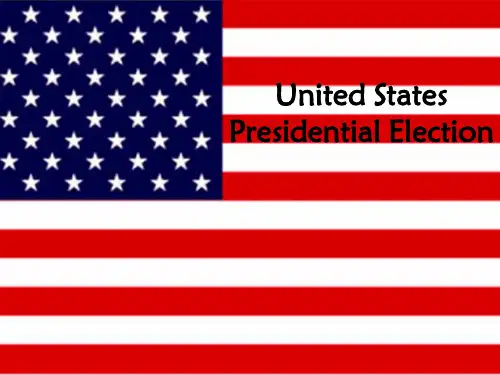
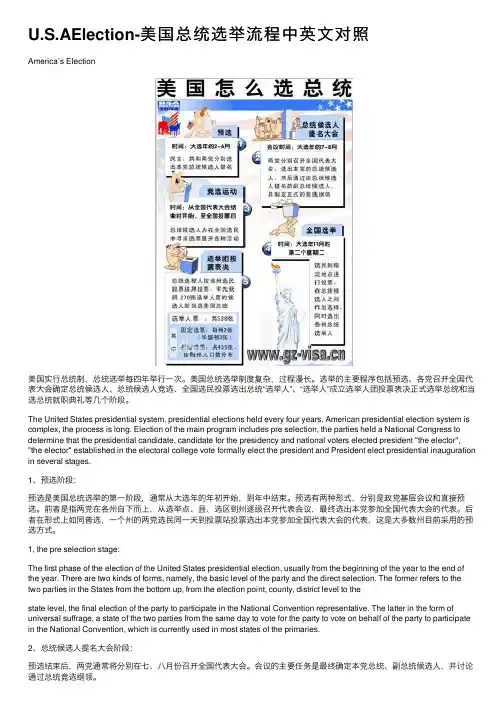
U.S.AElection-美国总统选举流程中英⽂对照America’s Election美国实⾏总统制,总统选举每四年举⾏⼀次。
美国总统选举制度复杂,过程漫长。
选举的主要程序包括预选、各党召开全国代表⼤会确定总统候选⼈、总统候选⼈竞选、全国选民投票选出总统“选举⼈”、“选举⼈”成⽴选举⼈团投票表决正式选举总统和当选总统就职典礼等⼏个阶段。
The United States presidential system, presidential elections held every four years. American presidential election system is complex, the process is long. Election of the main program includes pre selection, the parties held a National Congress to determine that the presidential candidate, candidate for the presidency and national voters elected president "the elector", "the elector" established in the electoral college vote formally elect the president and President elect presidential inauguration in several stages.1、预选阶段:预选是美国总统选举的第⼀阶段,通常从⼤选年的年初开始,到年中结束。
预选有两种形式,分别是政党基层会议和直接预选。
前者是指两党在各州⾃下⽽上,从选举点、县、选区到州逐级召开代表会议,最终选出本党参加全国代表⼤会的代表。
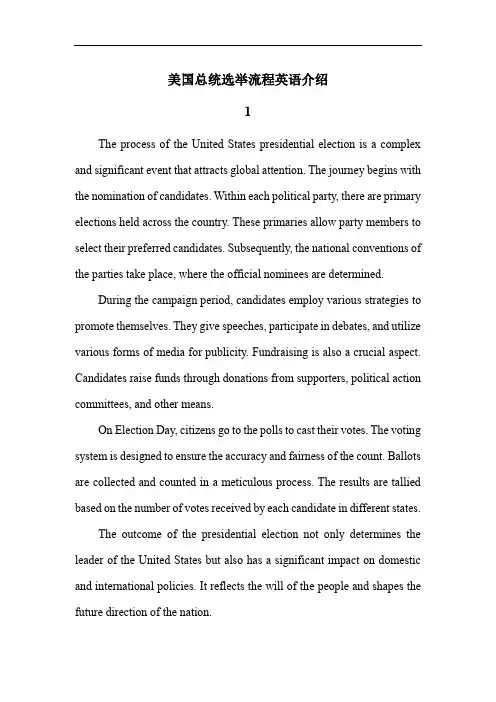
美国总统选举流程英语介绍1The process of the United States presidential election is a complex and significant event that attracts global attention. The journey begins with the nomination of candidates. Within each political party, there are primary elections held across the country. These primaries allow party members to select their preferred candidates. Subsequently, the national conventions of the parties take place, where the official nominees are determined.During the campaign period, candidates employ various strategies to promote themselves. They give speeches, participate in debates, and utilize various forms of media for publicity. Fundraising is also a crucial aspect. Candidates raise funds through donations from supporters, political action committees, and other means.On Election Day, citizens go to the polls to cast their votes. The voting system is designed to ensure the accuracy and fairness of the count. Ballots are collected and counted in a meticulous process. The results are tallied based on the number of votes received by each candidate in different states.The outcome of the presidential election not only determines the leader of the United States but also has a significant impact on domestic and international policies. It reflects the will of the people and shapes the future direction of the nation.2The process of the United States presidential election is a complex and elaborate system that involves multiple steps and factors. Before the actual election, public opinion polls and political debates play crucial roles. Public opinion polls provide an indication of the popularity and support for different candidates, influencing their strategies and messaging. Political debates offer a platform for candidates to showcase their policies, vision, and leadership skills, and to persuade the voters.The process also involves the selection of electors in each state. These electors are typically chosen based on the outcome of the popular vote within the state. Their role is significant as they cast the final votes for the president. For example, in some closely contested states, the number and distribution of electors can have a decisive impact on the overall election result.After the voting concludes, the certification of the election results is a critical step. This involves verifying and confirming the accuracy and validity of the votes counted. However, in some cases, disputes may arise, and there are mechanisms in place to address such controversies. These might include legal challenges, recounts in certain areas, or the involvement of judicial authorities to ensure a fair and legitimate outcome.In conclusion, the United States presidential election process is a highly regulated and structured system that aims to reflect the will of thepeople while ensuring the integrity and fairness of the electoral process.3The process of the United States presidential election is a complex and significant event that attracts global attention. It involves several crucial steps and factors.First of all, the eligibility and background checks of candidates are of paramount importance. Candidates must meet specific criteria, such as being a natural-born citizen of the United States, of a certain age, and having no disqualifying criminal records. This ensures that those who aspire to hold the highest office in the country have the necessary qualifications and integrity.The Electoral College system is another key aspect. It operates based on the distribution of electoral votes among the states. Each state has a certain number of electoral votes, and the candidate who secures the majority of these votes in a state wins all of that state's electoral votes. This system sometimes leads to situations where a candidate can win the popular vote but lose the Electoral College vote and, consequently, the election.During the election period, media coverage and public opinion play a significant role. The media provides extensive coverage of the candidates' policies, campaigns, and public appearances. This influences how the public perceives the candidates and their proposed policies, shaping theoverall discourse and public sentiment.In conclusion, the US presidential election process is a multi-faceted and intricate system that requires a combination of legal requirements, political strategies, and public engagement to determine the leader of the nation.4The process of the United States presidential election is a complex and highly regulated affair. Let me take you through the detailed steps.Firstly, voter registration is of paramount importance. It ensures that eligible citizens have the right to participate. The procedure involves filling out specific forms and providing necessary identification and proof of residency. For example, in some states, one must be registered a certain number of days before the election to be eligible to vote.Secondly, the issue of campaign funds cannot be overlooked. Campaign funds come from various sources such as individual donations, political action committees, and fundraising events. However, there are strict regulations and oversight to prevent illegal or excessive contributions. The monitoring of campaign finances is crucial to ensure a fair and transparent election process.Finally, when the voting concludes, the election results are announced. This is a highly anticipated moment that often attracts global attention. The newly elected president then goes through an elaborate inaugurationceremony, marking the official beginning of their term in office.In conclusion, the U.S. presidential election process is a comprehensive and meticulous system designed to reflect the will of the people and uphold the principles of democracy.5The process of the United States presidential election is a complex and highly significant event that shapes the course of the nation and has a global impact. It involves a series of elaborate steps and intense political manoeuvring.First and foremost, candidates from various political parties embark on a gruelling campaign trail, striving to convince the electorate of their suitability and policy proposals. The strategies employed by different parties are diverse and often influenced by the prevailing social and economic circumstances. They may focus on economic growth, social justice, or foreign policy, tailoring their messages to resonate with the concerns of the voters.The election also has a profound influence on both domestic and foreign policies of the United States. A new administration brings with it new priorities and directions, which can lead to significant shifts in areas such as healthcare, education, and international relations.Historically, there have been several landmark presidential elections that have brought about improvements to the electoral process. Forinstance, the 1960 election between John F. Kennedy and Richard Nixon marked a turning point in the use of television for political campaigns. This led to greater emphasis on image and presentation. Another example is the 2008 election of Barack Obama, which demonstrated the power of grassroots organising and digital campaigning.In conclusion, the United States presidential election process is not merely a democratic exercise but a reflection of the nation's evolving values and aspirations, constantly shaping and being shaped by the political, social, and economic landscape of the country.。
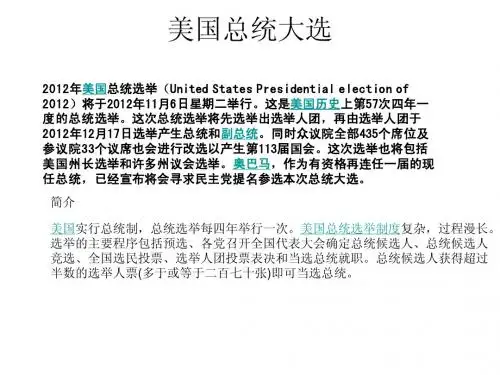
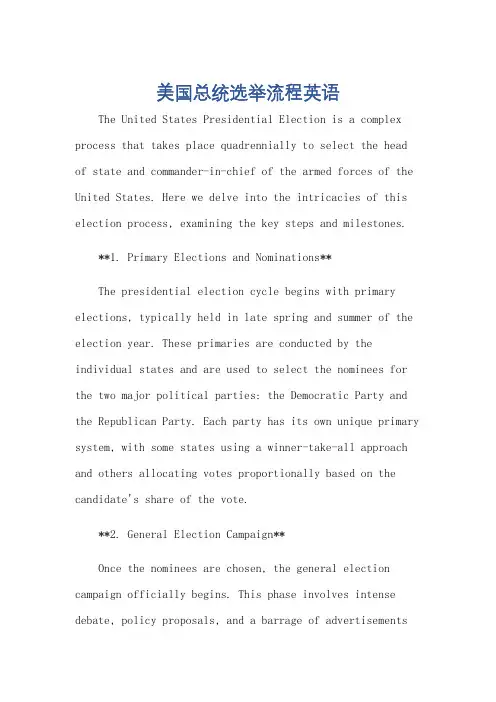
美国总统选举流程英语The United States Presidential Election is a complex process that takes place quadrennially to select the head of state and commander-in-chief of the armed forces of the United States. Here we delve into the intricacies of this election process, examining the key steps and milestones. **1. Primary Elections and Nominations**The presidential election cycle begins with primary elections, typically held in late spring and summer of the election year. These primaries are conducted by the individual states and are used to select the nominees for the two major political parties: the Democratic Party and the Republican Party. Each party has its own unique primary system, with some states using a winner-take-all approach and others allocating votes proportionally based on the candidate's share of the vote.**2. General Election Campaign**Once the nominees are chosen, the general election campaign officially begins. This phase involves intense debate, policy proposals, and a barrage of advertisementsand public appearances by the candidates. Both candidates engage in a series of debates, which are broadcast nationwide and provide an opportunity for the American people to hear directly from the nominees about theirvision for the country.**3. Voting Day**On Election Day, citizens of the United States cast their votes for president. The Election Day is always a Tuesday and is typically held in November of the election year. Voting takes place at designated polling stations throughout the country, and citizens can register to vote as long as they are US citizens, at least 18 years old, and have resided in their voting district for a certain period of time.**4. Electoral College**A unique feature of the American presidential election is the Electoral College. After the votes are cast, the elected officials of each state, known as electors, cast their votes for president. Each state is allocated a number of electors equal to the total number of senators and representatives it has in Congress. The candidate whoreceives a majority of the votes in a state wins all the electors from that state.**5. Counting the Votes and Inauguration**Once all the votes are cast and the electors have voted, the votes are tallied. The candidate who receives amajority of the votes cast by the electors becomes the president-elect. If no candidate receives a majority, the House of Representatives votes to select the president,with each state casting a single vote. The newly elected president is then sworn in during a ceremony known as the Inauguration, typically held in January of the yearfollowing the election.The presidential election process in the United Statesis a robust democratic mechanism that ensures the peaceful transfer of power and the representation of the will of the American people. From the primaries to the inauguration, it is a testament to the resilience and durability of American democracy.**美国总统选举流程深度解析**美国总统选举是一个每四年举行一次的重要过程,旨在选举出美国的国家元首和武装部队的总司令。
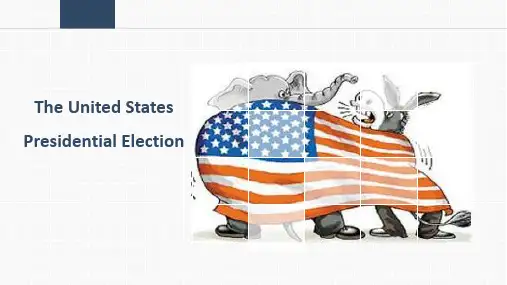
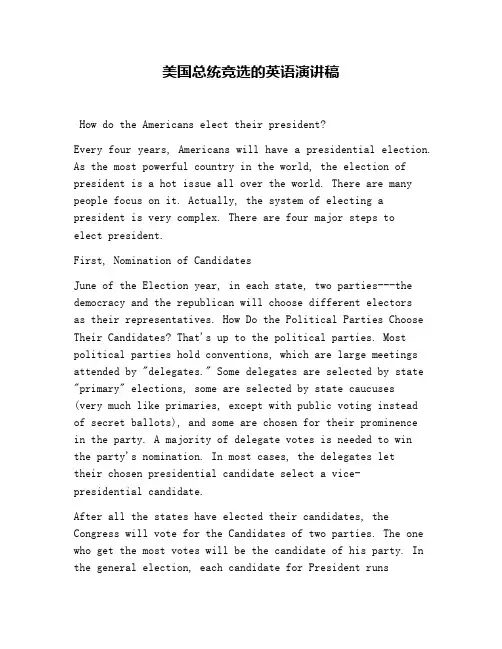
美国总统竞选的英语演讲稿How do the Americans elect their president?Every four years, Americans will have a presidential election. As the most powerful country in the world, the election of president is a hot issue all over the world. There are many people focus on it. Actually, the system of electing a president is very complex. There are four major steps toelect president.First, Nomination of CandidatesJune of the Election year, in each state, two parties---the democracy and the republican will choose different electorsas their representatives. How Do the Political Parties Choose Their Candidates? That's up to the political parties. Most political parties hold conventions, which are large meetings attended by "delegates." Some delegates are selected by state "primary" elections, some are selected by state caucuses(very much like primaries, except with public voting insteadof secret ballots), and some are chosen for their prominencein the party. A majority of delegate votes is needed to winthe party's nomination. In most cases, the delegates lettheir chosen presidential candidate select a vice-presidential candidate.After all the states have elected their candidates, the Congress will vote for the Candidates of two parties. The one who get the most votes will be the candidate of his party. In the general election, each candidate for President runstogether. They must be at least 35 years of age, they must be native-born citizens of the United States, and they must have been residents of the U.S. for at least 14 years. (Also, a person cannot be elected to a third term as President.)Second, the Campaign PeriodThe candidates of the parties will hold a campaign throughout the country. This is the most important period of election of president, usually from September to November. The forms of campaign include, give speeches in different states, and meet with votes and public debt with his rival candidate. The purpose of campaign is to gain support of people as much as possible. This is the most wonderful part.Third, Election for President VotersThe national presidential election actually consists of a separate election in each of the 50 states and the District of Columbia; in these 51 elections, the voters are really voting for "electors" pledged to one of the tickets. These electors make up the "Electoral College." Each state has the same number of electors as it has senators and representatives (there are two senators from each state, but the number of representatives depends on the state population in the most recent census). The District of Columbia, although it isn't a state, also participates in presidential elections -- it currently has three electors. Generally speaking, the voters will vote for the candidate who represents his party.Finally, Voters Vote the PresidentThe Electoral College then votes for President and for Vice-President, with each elector casting one vote; these votes are called electoral votes. Each elector is pledged to vote for particular candidates for President and Vice-President. In most elections, all the electors vote in accordance with the pledge they made; it is not clear what would happen in the unlikely event that a large number of electors violated their pledge and voted differently.Normally, one of the candidates for President receives a majority (more than half) of the electoral votes; that person is elected President. That candidate's vice-presidential running mate will then also receive a majority of electoral votes (for Vice-President), and that person is elected Vice-President. The result will be announced in the sixth day of January, the next year of election year.Through the above complex process, the new president will be elected. Although there are many arguments pro and con the Electoral College, but this system does guarantee that the person elected President has substantial support distributed throughout the U.S. The Electoral College has also been a major factor in the United States' long-term political stability.。
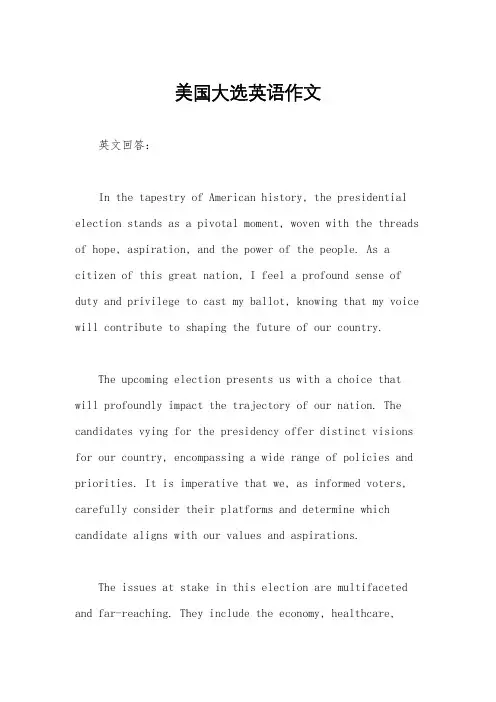
美国大选英语作文英文回答:In the tapestry of American history, the presidential election stands as a pivotal moment, woven with the threads of hope, aspiration, and the power of the people. As a citizen of this great nation, I feel a profound sense of duty and privilege to cast my ballot, knowing that my voice will contribute to shaping the future of our country.The upcoming election presents us with a choice that will profoundly impact the trajectory of our nation. The candidates vying for the presidency offer distinct visions for our country, encompassing a wide range of policies and priorities. It is imperative that we, as informed voters, carefully consider their platforms and determine which candidate aligns with our values and aspirations.The issues at stake in this election are multifaceted and far-reaching. They include the economy, healthcare,education, climate change, and foreign policy. Each ofthese areas has a direct impact on our daily lives and the well-being of our communities. It is essential that we thoroughly research these issues and understand their implications before making our decision.In addition to policy positions, it is equallyimportant to assess a candidate's character and temperament. The president of the United States is not merely a figurehead but a leader who serves as a role model for our nation and the world. We must elect someone who possesses integrity, empathy, and a unwavering commitment to the values enshrined in our Constitution.The upcoming election is also a testament to thestrength of our democratic system. Despite our differences, we come together as a nation to make our voices heard. The right to vote is a sacred privilege, and it is our responsibility to exercise it thoughtfully and responsibly.On Election Day, I will approach the ballot box with a sense of both excitement and trepidation. I know that myvote matters, and I am determined to make an informedchoice that will benefit our country and its future generations.中文回答:美国总统选举是美国历史上一个关键时刻,它交织着希望、抱负和人民的力量。
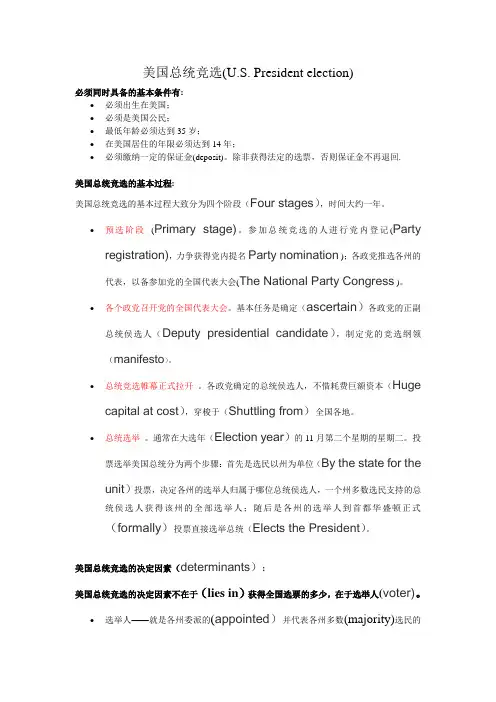
美国总统竞选(U.S. President election)必须同时具备的基本条件有:•必须出生在美国;•必须是美国公民;•最低年龄必须达到35岁;•在美国居住的年限必须达到14年;•必须缴纳一定的保证金(deposit)。
除非获得法定的选票,否则保证金不再退回.美国总统竞选的基本过程:美国总统竞选的基本过程大致分为四个阶段(Four stages),时间大约一年。
•预选阶段(Primary stage)。
参加总统竞选的人进行党内登记(Party registration),力争获得党内提名Party nomination );各政党推选各州的代表,以备参加党的全国代表大会(The National Party Congress )。
•各个政党召开党的全国代表大会。
基本任务是确定(ascertain)各政党的正副总统侯选人(Deputy presidential candidate),制定党的竞选纲领(manifesto)。
•总统竞选帷幕正式拉开。
各政党确定的总统侯选人,不惜耗费巨额资本(Huge capital at cost),穿梭于(Shuttling from)全国各地。
•总统选举。
通常在大选年(Election year)的11月第二个星期的星期二。
投票选举美国总统分为两个步骤:首先是选民以州为单位(By the state for the unit)投票,决定各州的选举人归属于哪位总统侯选人,一个州多数选民支持的总统侯选人获得该州的全部选举人;随后是各州的选举人到首都华盛顿正式(formally)投票直接选举总统(Elects the President)。
美国总统竞选的决定因素(determinants):美国总统竞选的决定因素不在于(lies in)获得全国选票的多少,在于选举人(voter)。
•选举人——就是各州委派的(appointed)并代表各州多数(majority)选民的意志(will)到首都华盛顿投票直接选举总统的人。
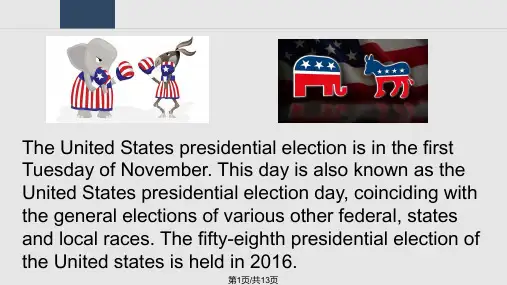
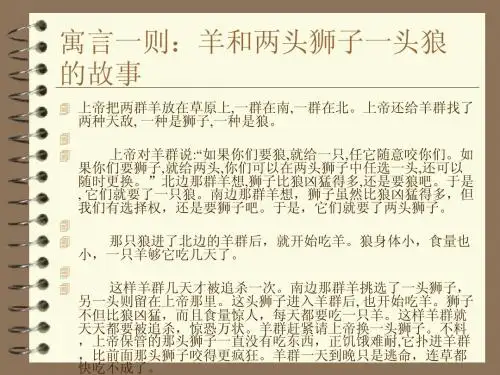
美国总统大选流程作文英语The United States Presidential Election Process。
Introduction。
The United States presidential election process is a complex and extensive system that determines the leader of the country. Every four years, American citizensparticipate in this democratic process to elect their president. This essay will explore the various stages and components of the U.S. presidential election process, including the primary elections, national conventions, general election, and the Electoral College.Primary Elections。
The first step in the U.S. presidential election process is the primary elections. These elections are held by the political parties to select their respective candidates for the presidency. Primaries are conducted on astate-by-state basis, where registered party members cast their votes to choose their preferred candidate.There are two types of primaries: closed and open. In closed primaries, only registered party members can participate, while in open primaries, voters can choose which party's primary they want to vote in, regardless of their party affiliation. Primaries are crucial as they determine the candidates who will represent their respective parties in the general election.National Conventions。